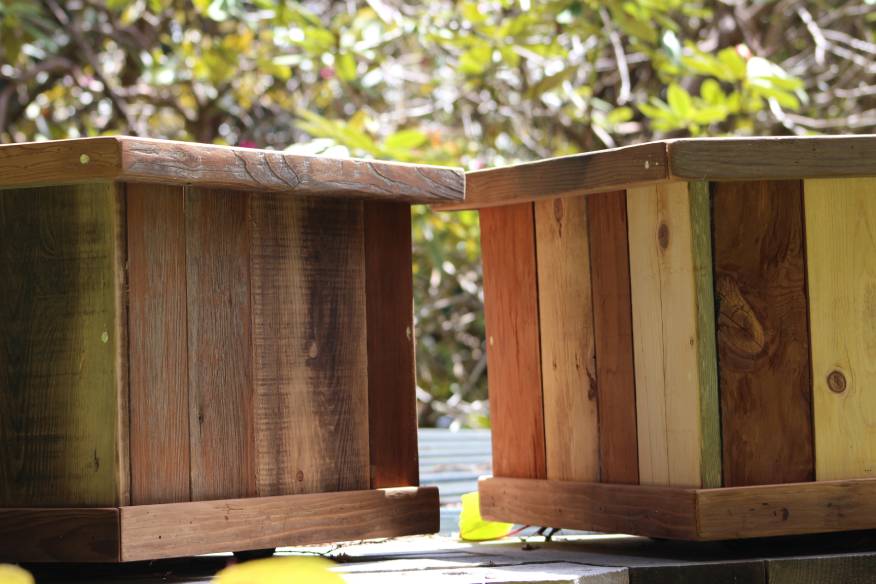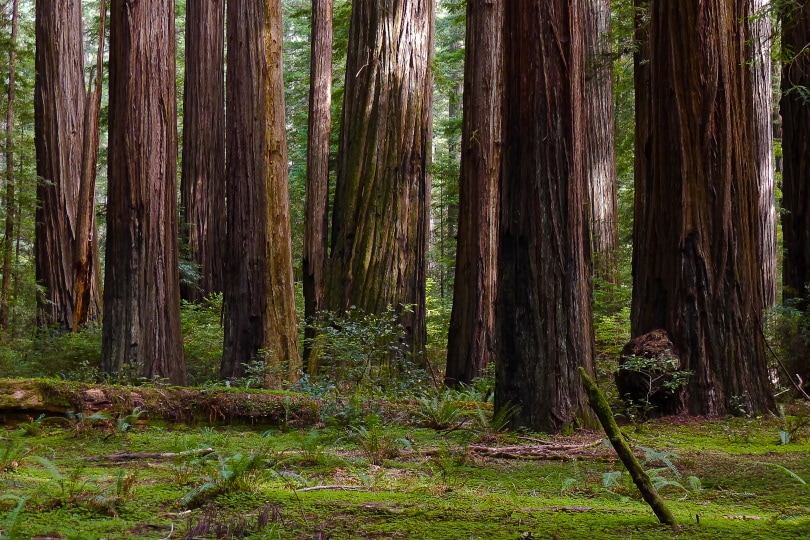Cedar vs. Redwood: What’s Best for My Project?
-
Shea Cummings
- Last updated:

A successful woodworking project begins with choosing your lumber. Whether you’re building a deck, a fence, furniture, or anything else, a critical factor is choosing the type of wood meant for the application.
For many years, cedar and redwood have been great choices for indoor or outdoor use because of their natural moisture resistance and overall great durability. Below, we’ll compare each wood’s appearance, durability, and common uses.
 Overview of Cedar
Overview of Cedar
One of the most common cedar trees in the United States is the western red cedar. This type of cedar is prized for its excellent color, durability, and iconic sweet cedar smell. Considering the variety of environments that cedar trees thrive in, their durability is obvious.

Appearance
Unfinished cedar usually takes on a slight yellowish hue over time. This is dependent on the particular grade you get. For example, the yellowish hue is really noticeable with western red cedar. On the other hand, if you end up staining it, the color will be whatever you decide.
Cedar is available in 10 different grades. The grain pattern you get is dependent on which grade you go with. However, cedar typically has a smooth straight grain, which contributes to it being a great wood to work with for many projects.
Even though it’s not the smoothest wood available, this isn’t a determining factor because we have access to tools that can make it as smooth as almost any other wood.
Durability
The Janka hardness test is how hardness is measured in wood. Cedar has a Janka rating of 350 pounds (lbs). So, it’s not the hardest wood out there. However, if you don’t need the hardness specifically, cedar is durable in its own way.
Cedar has an excellent natural resistance to water and pests due to the natural oils it contains. These natural resistances make it great for outdoor projects, especially if you want to leave it natural.

- Fences
- Decks
- Siding
- Boatbuilding
- Musical Instruments
- Furniture
 Overview of Redwood
Overview of Redwood
Redwood is a common wood on the west coast of the United States. As a result, it’s widely available and inexpensive. However, if you live on the east coast, the price of redwood and its availability change drastically.
Because it’s available in knot-free cuts, redwood is used commonly as structural lumber because of its hardness and natural resistances.

Appearance
Compared to cedar, redwood comes in around 30 different grades, and typically the trees are much older, as you can tell by how massive redwood trees are. You can also get a “clear” grade that will have no knots.
Redwood has a rich, reddish-brown color that many find attractive for deck and fence projects. With only a clear coat, it has a beautiful finish.
Durability
A significant and unique feature of redwood is that it’s naturally fire-resistant. Also, with a Janka rating of 450lbs, it’s around 23% harder than cedar. This makes it a great choice if you’re looking for lumber with good structural integrity.
In addition to being a relatively hard wood, redwood also has significant natural water and pest resistance. So, it doesn’t have to be finished. However, sealing it will make for easier maintenance over its lifetime.

- Veneers
- Construction beams
- Fencing
- Decks
- Furniture
- Exterior house trim
- Musical instruments
Further Comparisons Between Cedar and Redwood
We’ve taken a look at the basic rundown of each wood. Now, we’ll go through a couple of side-by-side comparisons to give you a good idea of which one is right for your project.
Price and Availability
There is no universal pick for one or the other regarding price and availability because it depends on where you live. If you’re on the west coast of the States, the chances are good that redwood will be much cheaper than cedar and more readily available.
On the other hand, if you live in or near a state that grows cedars like Texas, for example, you will have better access to cedar.
So, if there is no real necessity for one or the other, you’re better off using whichever is cheapest in your area.

Eco-Friendliness and Sustainability
If you’re in the United States or Canada, both cedar and redwood lumber is reasonably eco-friendly due to not having to be shipped long distances.
As for sustainability, again, both trees are sustainably harvested now. And this is a good thing because it takes 50 or more years to regrow the trees! If there had to be a pick of a slightly more sustainable, it would have to go to redwood.
However, sustainable logging practices are in place for both species, and neither will be gone anytime soon.
When to Use Cedar vs. Redwood
| When to Use Cedar | When to Use Redwood |
| Fencing | Fencing |
| Decks | Decks |
| Furniture | Furniture |
| Musical instruments | Musical instruments |
| Boatbuilding | Exterior house trim |
| Construction beams |
 Conclusion
Conclusion
As you can see by the comparisons, there is no universal winner between cedar and redwood. Economically, the one you’ll want to use is determined by where you live. But more importantly, what your particular project calls for should be the main deciding factor.
With that being said, both kinds of wood have a lot of similar ideal applications, so your personal preference for color and looks is also a factor.
- See Also: 5 Tips to Winterizing Your Lawnmower
Featured Image Credit: Left: Cedar Wood: Jon-Spalding, Shutterstock | Right: Redwood: PublicDomainPictures, Pixabay
Contents
 Overview of Cedar
Overview of Cedar